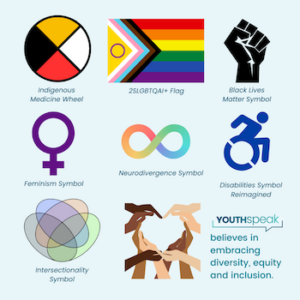
*Diversity, Equity, and Inclusion (D.E.I.) in America is affirmed on this date in 1965. This is a policy that levels the presence of non-white, disabled, female, aged, and binary citizens.
D.E.I. is in the private and public sectors of education and business. As educational subjects began to diversify more in the 1960s, student bodies did too. Many colleges and universities began considering race as a factor in student admissions starting in the 1960s, as a result of the 20th-century American Civil Rights movement. One year after the 1964 Civil Rights Act was passed, Black employees at Xerox founded the first employee resource group to advocate for equal pay and against workplace discrimination.
By 1969, elite universities across the country admitted twice as many Black students as in previous years. In education, at the height of student activism in the 1960s, one in five student protests demanded an end to racial discrimination on campus; as a result of these numerous demonstrations (including a campus shutdown at the University of Minnesota and Michigan), some of the first African American studies departments were established. The first Black Studies department started at San Francisco State College in 1968. After five months, San Francisco State College made a novel commitment to admit more than twice as many non-white students the following year and created departments and classes that focused on the stories of minority communities.
But policy changes came with backlash as white students went to court to fight for their admission into college, just two years after affirmative action went into effect. Notably, in the landmark case of Regents of the University of California v. Bakke, the Supreme Court ruled against using a quota system to select students based on demographics, forcing many schools to revise their affirmative action policies. Even in colleges with more diverse student bodies, retention rates remained low. Although twice as many Black students were at Columbia in 1969, only half received their degrees.
Affirmative action's historical impact.
In 1976, white students comprised over 80% of all U.S. college students; however, this percentage dropped to 57% by 2016. As the nation diversifies, higher education has begun to acknowledge how language and educational barriers can misrepresent a student's learning and intelligence. In the 21st century, around 450 of these departments and programs remain, along with a legacy of multicultural education that continues to shape and inspire younger generations of scholars and thinkers. Throughout the 1970s, other minority business groups began forming employee resource groups (ERGs), and the tech industry was at the forefront of this shift.
The Hispanic Association for Professional Advancement (Xerox), the Gay and Lesbian Employee Network (Hewlett-Packard), and LEAGUE (AT&T) all emerged in the wake of Title VII. Those ERGs not only helped non-white workers organize and gain visibility, but they also often became professional development networks for these workers. The Blacks at Microsoft (B.A.M.) ERG offers scholarships to empower more Black students to pursue careers in technology. Other D.E.I. initiatives helped employees of all races adjust to newly integrated workplaces. Diversity training, for example, encouraged tolerance between coworkers and informed teams about new equal employment laws and HR policies.
Mentoring and managerial training were introduced to help minority employees grow and make meaningful connections throughout the organization. The term 'diversity' was first introduced to global business circles in 1990. It came via an article in Harvard Business Review called 'From Affirmative Action to Affirming Diversity' by R. Roosevelt Thomas, formerly an assistant professor at Harvard Business School.
Thomas asked organizations to move beyond affirmative action to 'managing diversity,' shifting the focus from hiring women to maximizing the potential of every person in a company. He recognized the importance of hiring people who are different from the dominant norm and who bring diverse thinking approaches. He said an exclusionary organization needs to include: 'Executives who only sponsor people like themselves are not making much of a contribution to the cause of getting the best from every employee.' This was an important insight to bring to the corporate landscape.
The concept of sponsoring Black and other non-white people is now widely recognized as a form of 'affinity bias (or 'usual suspects bias) that inhibits diversity in hiring and career development. In 2023, the Supreme Court's decision to ban affirmative action in college and university admissions was a watershed moment for far-right conservatives. Since the ruling, some companies, such as Zoom, Lyft, and Meta, have voluntarily dismantled their efforts to promote and increase diversity, without any specific legal incentive. However, several other entities have followed suit after facing legal challenges.
Since President Trump returned to the White House, he has issued executive orders that target diversity, equity, and inclusion initiatives, dismantling decades of federal anti-discrimination policies.